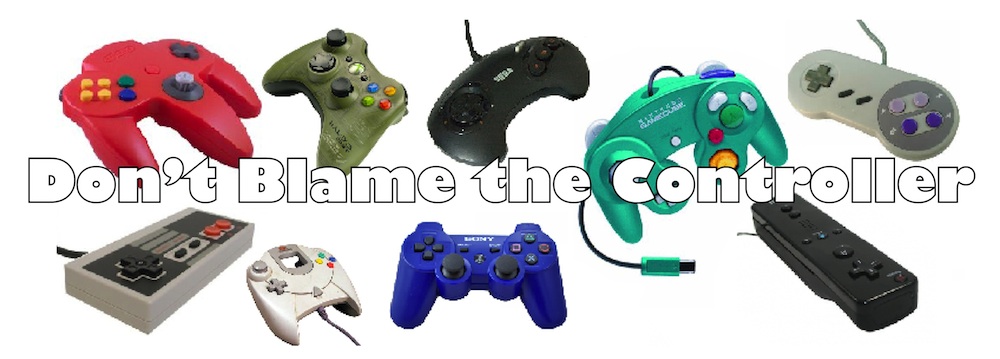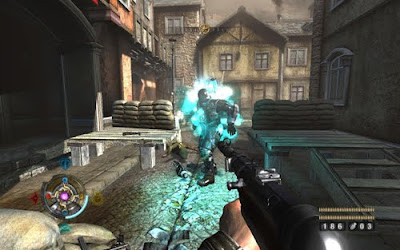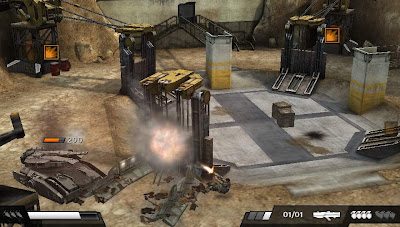A look back at Rare's masterwork and the franchise it inspired...
Fourteen years ago today, Banjo-Kazooie debuted in North America for the Nintendo 64. It was one of a handful of all-time great games that appeared in 1998, along with StarCraft, Half-Life, Metal Gear Solid, and The Legend of Zelda: Ocarina of Time, another N64 game. For some reason or another, Banjo-Kazooie hasn't appreciated in value like those other titles. Critics' top 100 lists regularly contain games like Half-Life and Ocarina of Time, but rarely do they feature Banjo-Kazooie. In 1998, however, the game was a hit. Banjo-Kazooie launched to great critical and commercial acclaim: it maintains a score of 92 and 93 on Metacritic and GameRankings, respectively; and it sold nearly two million copies in the United States alone. This success led to a sequel two years later, and a handful of games after that. There are five Banjo-Kazooie games in total: four from the main series, one spin-off. The original is still the best, however, and it wouldn't have happened without one of the most productive partnerships in the history of gaming.
A Rare Gem
The British game company Rare (then known as Rareware) developed Banjo-Kazooie and all its sequels. Rare was hugely important to Nintendo in the years between 1994 and 2001, when it functioned as a second-party developer for the gaming giant. Among the games Rare produced in this period are Donkey Kong Country, Blast Corps, GoldenEye 007, Perfect Dark, Diddy Kong Racing, and Conker's Bad Fur Day, along with Banjo-Kazooie and its sequel Banjo-Tooie. Since being purchased by Microsoft in 2002, Rare has fallen on hard times. The once great video game company is now relegated to making games for the Xbox 360 peripheral Kinect. Ironically, one of Rare's best games during the Microsoft era was a Banjo-Kazooie game -- Banjo-Kazooie: Nuts & Bolts, which was released in 2008, ten years after the original game arrived in North America.
Original Recipe
Believe it or not, Banjo-Kazooie started off as a SNES game. Codenamed "Dream," it was an adventure game staring a young boy with a wooden sword who fan afoul of pirates. Three year after development on "Dream" began, Rare ported its code from the SNES to the N64, revised the concept, replaced the boy with a bear, and produced Banjo-Kazooie. The game's heroes are Banjo, a big, dopey bear, and Kazooie, a wise-cracking "breegull" who serves as Banjo's best friend, partner, and sometimes weapon. When the vain and powerful witch Gruntilda kidnaps Banjo's kid sister, it's up to the dynamic duo to save the day.
Many critics compared Banjo-Kazooie to Super Mario 64, which had been released two years earlier. The games certainly shared many gameplay elements, but Banjo-Kazooie was technically superior and much more focused on exploration than on platforming. Jeff Gerstmann, who wrote a review for GameSpot, summed it up nicely:
Fourteen years ago today, Banjo-Kazooie debuted in North America for the Nintendo 64. It was one of a handful of all-time great games that appeared in 1998, along with StarCraft, Half-Life, Metal Gear Solid, and The Legend of Zelda: Ocarina of Time, another N64 game. For some reason or another, Banjo-Kazooie hasn't appreciated in value like those other titles. Critics' top 100 lists regularly contain games like Half-Life and Ocarina of Time, but rarely do they feature Banjo-Kazooie. In 1998, however, the game was a hit. Banjo-Kazooie launched to great critical and commercial acclaim: it maintains a score of 92 and 93 on Metacritic and GameRankings, respectively; and it sold nearly two million copies in the United States alone. This success led to a sequel two years later, and a handful of games after that. There are five Banjo-Kazooie games in total: four from the main series, one spin-off. The original is still the best, however, and it wouldn't have happened without one of the most productive partnerships in the history of gaming.
A Rare Gem
Original Recipe
Believe it or not, Banjo-Kazooie started off as a SNES game. Codenamed "Dream," it was an adventure game staring a young boy with a wooden sword who fan afoul of pirates. Three year after development on "Dream" began, Rare ported its code from the SNES to the N64, revised the concept, replaced the boy with a bear, and produced Banjo-Kazooie. The game's heroes are Banjo, a big, dopey bear, and Kazooie, a wise-cracking "breegull" who serves as Banjo's best friend, partner, and sometimes weapon. When the vain and powerful witch Gruntilda kidnaps Banjo's kid sister, it's up to the dynamic duo to save the day.
 |
| Kazooie lives in Banjo's backpack. It's not weird. You're weird! |
Many critics compared Banjo-Kazooie to Super Mario 64, which had been released two years earlier. The games certainly shared many gameplay elements, but Banjo-Kazooie was technically superior and much more focused on exploration than on platforming. Jeff Gerstmann, who wrote a review for GameSpot, summed it up nicely:
"A lot of people are writing off Banjo-Kazooie as a Super Mario 64 clone. Now let's think about this for a bit. Mario 64 was a revolutionary game. It redefined what people expected from a platform game. Banjo-Kazooie follows in the footsteps of Mario 64. It doesn't stray too far from the formula, but it makes the logical progressions you would expect Nintendo to make. "Banjo-Kazooie also surpassed Super Mario 64 in terms of collectables: the bear and bird duo could collect "jiggies," golden jigsaw pieces that opened new worlds, along with musical notes, feathers, eggs, honeycombs, and Mumbo tokens, which allowed Banjo to transform into a special animal that could travel to normally inaccessible areas.
Two is (Almost) Better than One
After the huge success of Banjo-Kazooie, Rare started work on a sequel. In 2000, Banjo-Tooie arrived in stores. In many ways, Banjo-Tooie is a better game than its predecessor. The sound effects, music, and graphics are phenomenal. How Rare crammed so many animations, particle effects, and huge, expansive environments into a single cartridge without the help of the expansion pak is a mystery; although the improved, high-power graphics come with a price -- random dips in frame rate.
 |
| Banjo faces two Split-Up pads, which allow the duo to separate. |
Banjo-Tooie is much bigger in size and scope than its predecessor. Whereas in Banjo-Kazooie, players could access (and conquer) each world via a magical portal, all of the worlds in Banjo-Tooie are connected. This allows missions to span several different environments instead of being limited to a discrete world. In a sense there are no "levels" in Banjo-Tooie, only a sprawling open-world hub with interconnected areas. Other additions include Split-Up pads, which allow players to control Banjo and Kazooie separately, dozens of new unlockable moves, and lots of genre-mashing episodes, including one where Kazooie functions as a gun in a first-person shooter. Banjo-Kazooie currently holds an aggregate score of 90 and 91 on Metacritic and GameRankings, respectively.
Well in Hand
Like most of the popular Nintendo franchises, Banjo-Kazooie was shrunk down from the home console to a handheld system, in this case the Game Boy Advance (GBA). Rare developed two titles for the GBA that were published by THQ: Banjo-Kazooie: Grunty's Revenge, an interquel that takes place between Banjo-Kazooie and Banjo-Tooie; and Banjo Pilot, a racing game similar to Mario Kart. Taking full advantage of the GBA hardware (and using some graphical tricks of their own) Rare managed to convincingly transfer the 3D feel and look of the console B-K games onto a much small screen. Despite its top-down point-of-view, Grunty's Revenge retains all the hallmarks that make the franchise so rewarding and addictive. It's an unknown and underrated gem.
 |
| Banjo Pilot (left) and Grunty's Revenge (right). |
Banjo Pilot, on the other hand, had nothing to do with the Banjo-Kazooie storyline. Originally developed as a follow-up to Diddy Kong Racing, Banjo Pilot was retooled after the Microsoft buy-out to feature Rare characters. Despite all the delays and revisions, Banjo Pilot is a competent racing game with a strong multiplayer mode and good replay value. Overall, however, it's easily the weakest entry in the series.
Are you Nuts?
The fifth and (possibly) final Banjo-Kazooie game arrived on the Xbox 360 in 2008. Titled Banjo-Kazooie: Nuts & Bolts, the game represented a significant departure from the series. Instead of exploring, collecting, and jumping through monster-infested worlds, Banjo and Kazooie must buy, build, and compete. Musical notes are still an important part of the game, but in Nuts & Bolts, they are currency used to buy over 1,500 unique vehicle parts that can be combined to create cars, boats, planes, and helicopters. The purpose of Nuts & Bolts, which is cleverly self-referential and self-deprecatory, is to use these improvised creations to complete vehicular challenges.
 |
| One of dozens of challenges in Nuts & Bolts. |
By releasing a Banjo-Kazooie game based on a vehicle construction engine, Rare betrayed a fundamental misunderstanding of its fans. Still, Nuts & Bolts is the best B-K game since Tooie. It may not be the traditional platform game people wanted, but it's still one of the better and most unique games available on the Xbox 360.
Coming up Next
A proper sequel to Banjo-Tooie is probably a pipe dream. As of now, Rare is mostly a shell of its former self, restricted to working on Kinect projects for Microsoft. Moreover, the British company has shown no interest in returning to its classic franchises. It's a shame. Banjo-Kazooie is worthy of a larger franchise. Its characters are wacky, its writing hilarious, its mechanics masterful, its gameplay nothing short of brilliant. Yet somehow the bear and bird duo got lost among all the other video game mascots of the 1990s and 2000s.
The good news is that the older games are still around and ready to be played. If you can't find the N64 cartridges of Banjo-Kazooie and its sequel on eBay, both games are available for download on Xbox Live Arcade. Nuts & Bolts, which attained Platinum Hits status, can be purchased rather cheaply from Amazon.com or GameStop. Happy playing!






































